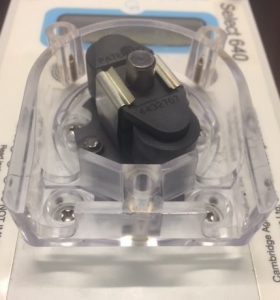Tube changing with Select Dosers…why does it matter?
Many types of dosing pumps just can’t handle the delivery of aggressive chemicals such as acids or chlorine. The corrosive effect of these products on lesser plastic and metal components makes them a difficult job to handle. Due to this, peristaltic pumps like the Select Doser are the obvious choice to dose these more chemically aggressive products into water.
Peristalsis (squeezing the outside of a tube to create suction) allows the main components of the Select Doser to have no contact with the additive during dosing. At least, this is how it works when both doser and tube are in full working order. As you can imagine, the constant pressure on the outside of the tube does wear them out over time. Because of this, we always recommend changing the pump tube on a Select Doser after 1 month of use.
What happens when you don’t change the tube?

Take a look at the picture of a Select Doser pumphead shown above. As you can see the rollers of the machine (the part which applies pressure to the pump tube) are made from metal.
If the tube is not changed before it is worn out it will eventually fracture; causing the pure additive (let’s say chlorine for example) into the pumphead. When chlorine comes into contact with metal, the chemical reaction is quite violent. The metal rusts and the chlorine “gasses-off”. Once this happens, the metal rollers will quickly seize and can also fuse onto the motor shaft. Removing the rollers from the pump then requires force, usually from a hammer, which can damage the motor itself.
Even if the rollers don’t completely fuse onto the motor shaft, one or both of the rollers may have seized. The result of this is that instead of rolling across the outside of the pump tube during operation, they will now drag across it. This will wear out the next tube a lot faster and increase the risk of future chemical spills.

The result of an acid or chlorine spill can be seen in the second picture. Once this happens, what could have been prevented with a $20 rubber tube turns into a comprehensive repair costing well over $100, or even more depending on how long the pumphead was left full of chemicals.
What can I do to prevent damage to my doser?
In an ideal world, all Select Doser owners would proactively change their tubes before these fractures occur. Of course, we don’t live in an ideal world and sometimes we just get too busy to change this ahead of an issue. So, please find a couple of options below to prevent serious damage.
- Change the tube. This is by far the surest and most cost-effective way of preventing serious chemical damage with a Select Doser. Changing the tube every month if the doser is in constant use is advised. If the doser is only used for short bursts of time then shelved for a while, it may be simpler to just change the tube before use. This is an easy-to-remember method that will save you a lot of heartache in the long run.
- If a chemical spill occurs, avoid leaving the doser running with chemicals in the pump-head. Remove the tube, rollers and magnet plate. Then thoroughly clean both those components and the inside of the pumphead. Make sure to dry them off before re-assembly. If this is done quickly, it can stop major damage from occurring.
- If you are regularly working with corrosive chemicals like acids or chlorine, we can actually switch out the standard metal rollers for a plastic set. These rollers work in the same way, but aren’t so badly effected by acids and chlorine. I must stress that it is still important to change the tube if you decide to go this way, as chemical spills can still effect the machine in other ways, but plastic rollers buy you a bit of time in the event of a spill.
